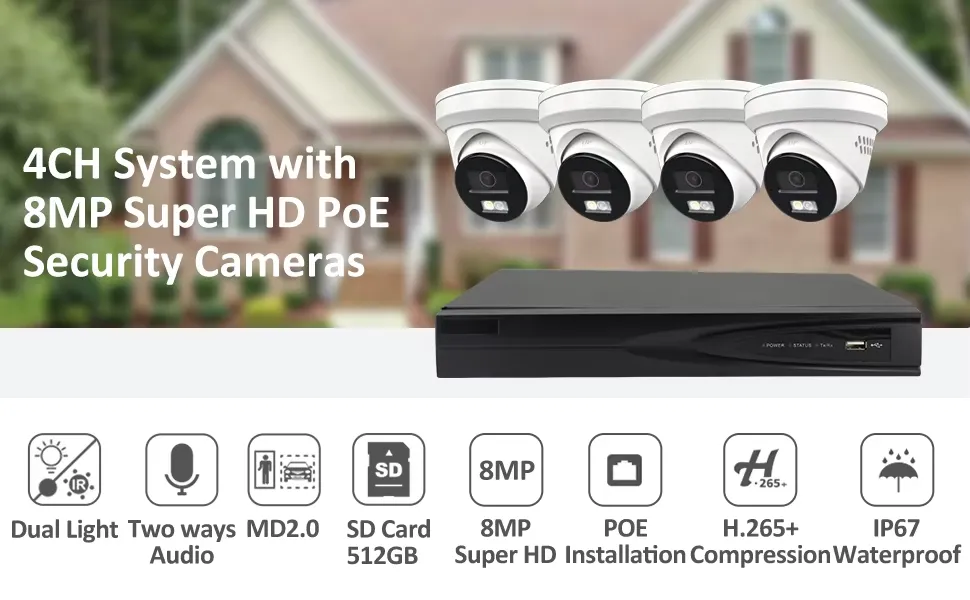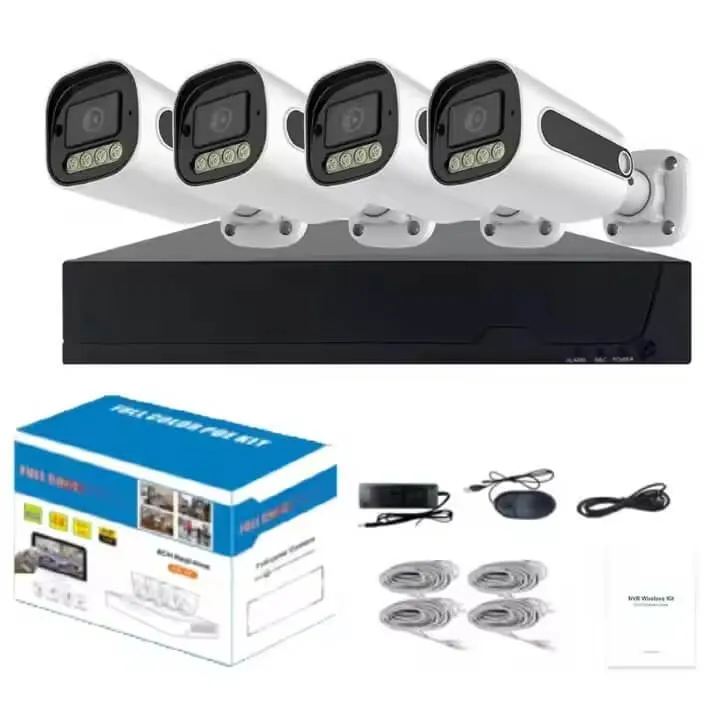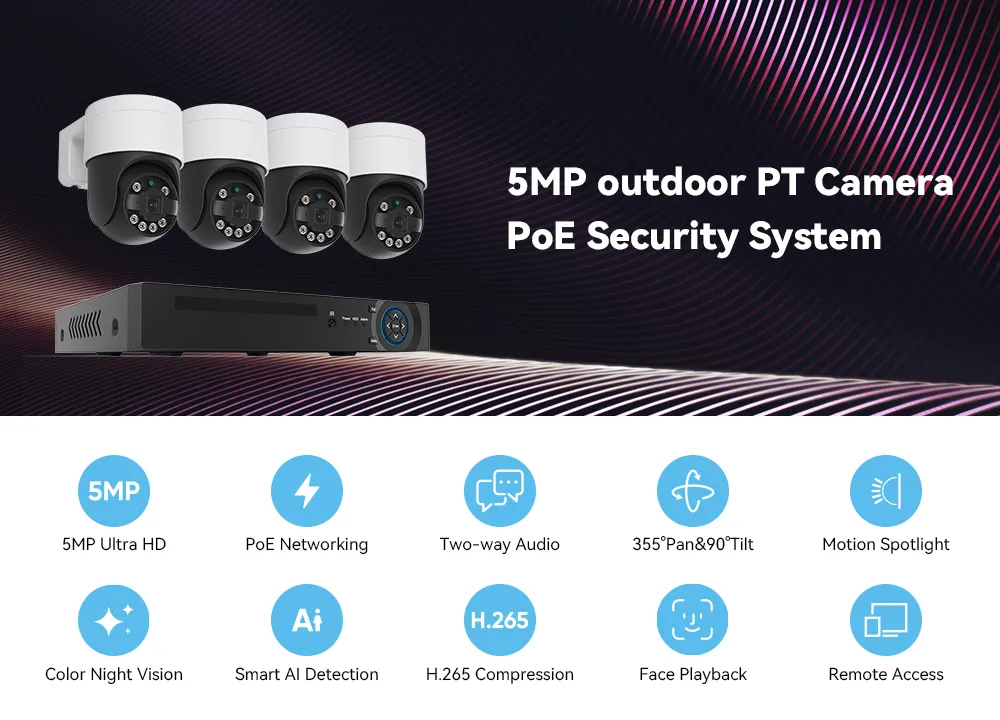Hybrid DVRs represent a powerful solution for businesses navigating the challenging transition between analog and IP surveillance systems. These versatile recorders bridge the gap between older analog cameras and newer IP technology, providing unprecedented flexibility in security system design. As organizations face the dilemma of upgrading aging surveillance infrastructure without discarding functional equipment, hybrid DVRs offer a practical pathway that balances current needs with future capabilities.
What Are Hybrid DVRs and Why Do They Matter?
Hybrid DVRs represent the perfect middle ground for businesses caught between legacy systems and modern surveillance technology. As a security installation specialist, I’ve seen countless clients struggle with the analog-to-IP transition question: “Do we scrap everything and start fresh, or stick with outdated equipment?
The beauty of hybrid solutions is that you don’t have to choose. These versatile recorders accept both traditional BNC-connected analog cameras and network-based IP cameras through the same device. This dual functionality creates remarkable installation flexibility during system upgrades.
In practical terms, a hybrid DVR might connect to existing analog cameras monitoring your warehouse while simultaneously supporting new 4K IP cameras at critical entry points. The cost savings can be substantial – security industry data suggests businesses save 40-60% on upgrade costs by taking the hybrid approach rather than complete system replacement.
| Camera Type | Connection Method | Resolution Range |
|---|---|---|
| Analog | BNC/Coaxial | 480p-960H |
| IP | Ethernet | 1080p-4K |
For businesses planning gradual security upgrades, this approach provides breathing room financially while maintaining continuous surveillance coverage. Need help determining if a hybrid DVR fits your security needs? Our team can assess your current setup and recommend the optimal migration strategy.

How Do Hybrid DVRs Work With Different Camera Types?
Now that we understand what hybrid DVRs are, let’s dive into their remarkable technical operation. As a security systems specialist at JER-Tech, I’m often asked: “How exactly do these devices juggle both analog and IP camera feeds simultaneously?”
The secret lies in specialized connection interfaces and sophisticated encoding processes. I tell my clients to think of hybrid DVRs as bilingual translators for surveillance—they speak both the analog and digital languages fluently.
On one side, the DVR connects to analog cameras through BNC connectors and coaxial cables. These raw signals undergo an impressive transformation: the DVR’s hardware encoder converts analog signals to digital, then compresses them (usually H.264/H.265) for storage efficiency.
For IP cameras, the process is entirely different. These smart devices handle their encoding and send pre-compressed digital streams to the DVR via network cables. The hybrid DVR’s software then manages these streams, handling various protocols and compatibility issues that would otherwise cause headaches.
| Signal Process | Analog Cameras | IP Cameras |
|---|---|---|
| Encoding Location | Inside DVR (Hardware) | Inside Camera (Software) |
| Data Transmission | Raw Signal via Coax | Compressed via Ethernet |
The awe-inspiring part? These systems synchronize everything perfectly while handling dramatically different resolution capabilities—from 960H analog to crystal-clear 4K from IP cameras. Have questions about optimizing your specific camera mix? Contact our technical team for a personalized assessment.
What Cost Benefits Do Hybrid DVR Systems Offer?
Having explored the technical operation of hybrid DVRs, let’s talk about everyone’s favorite topic: saving money! As a security systems consultant at JER-Tech, I’ve helped dozens of businesses unlock significant financial benefits through hybrid DVR implementation.
The cost advantages go far beyond simple equipment savings. For budget-conscious security managers, hybrid solutions typically reduce upgrade expenses by 40-60% versus complete system overhauls. How? By strategically preserving those functional analog cameras while adding high-resolution IP cameras only where truly needed.
Let me share a real-world example. For a standard 16-camera system, going full-IP might cost $8,000-$12,000, including cameras, networking equipment, installation labor, and facility modifications. The hybrid approach? Typically just $3,500-$5,000 for the same coverage area. That’s serious money back in your budget.
| System Type | Typical Cost (16 cameras) | Installation Time |
|---|---|---|
| Full IP Replacement | $8,000-$12,000 | 3-5 Days |
| Hybrid Solution | $3,500-$5,000 | 1-2 Days |
Perhaps the most underappreciated benefit is the phased investment approach. Rather than one massive capital expense, you can spread camera upgrades across a 3-5 year timeline. This creates predictable budget cycles while still delivering immediate management improvements. Need help calculating potential savings for your specific setup? Our team provides free cost analysis consultations to quantify your exact savings potential.

What Features Should You Look For in a Quality Hybrid DVR?
Now that we understand the cost benefits, let’s focus on what matters in a quality hybrid DVR. After installing hundreds of systems at JER-Tech, I’ve developed a discerning eye for the features that separate the truly capable units from the marketing hype.
First, scrutinize channel flexibility. The best hybrid DVRs allow you to customize your analog-to-IP ratio rather than locking you into fixed configurations. This adaptability means your recorder evolves with your needs, perhaps starting with 12 analog/4 IP cameras and gradually shifting to 8 analog/8 IP as you upgrade.
Storage capacity isn’t just about raw terabytes. Look for RAID support to protect your footage from drive failures, and at least 8TB expandable capacity to handle those storage-hungry high-resolution IP streams. I’ve seen too many clients outgrow their storage within months of installation!
| Feature Category | Entry-Level | Enterprise-Grade |
|---|---|---|
| Channel Allocation | Fixed Ratio | Flexible/Customizable |
| Storage | 2-4TB (Single Drive) | 8TB+ (RAID Support) |
| Remote Access | Basic App | Multi-site Management |
Remote access capabilities have transformed from nice-to-have into absolutely essential. The difference between basic mobile viewing and comprehensive multi-site management can be dramatic in everyday use. Need help identifying the right specifications for your environment? Our team provides free feature consultations tailored to your specific security requirements.
How Should You Plan Your Hybrid Surveillance System?
After identifying the right hybrid DVR features, the next critical step is creating a methodical implementation plan. At JER-Tech, I’ve seen hasty deployments create more problems than they solve. A structured approach reduces implementation risks by an impressive 40%.
Start with a thorough audit of your existing surveillance equipment. Document everything: camera locations, types, conditions, and the security objectives for each area. This groundwork lets you identify critical zones needing immediate IP camera upgrades, typically entry points, cash handling areas, and operational centers.
Next comes the often-overlooked network impact analysis. This crucial step calculates bandwidth requirements based on camera specs and prevents that dreaded “why is everything suddenly lagging?” conversation with your IT department.
| Camera Type | Typical Bandwidth | Storage per Day |
|---|---|---|
| Analog (960H) | 1-2 Mbps | 10-20 GB |
| IP (1080p) | 4-8 Mbps | 40-80 GB |
| IP (4K) | 16-32 Mbps | 150-300 GB |
Storage planning follows a similar formula: camera count × resolution × frame rate × compression × retention period. Many of my clients adopt tiered storage, recent footage on fast local drives before archiving to lower-cost options.
Finally, create a phased implementation schedule aligned with budget cycles. This approach minimizes disruption while delivering immediate improvements where they matter most. Need expert help developing your migration plan? Our planning consultants can save you countless headaches.

Why Choose Shenzhen JER Technology for Hybrid DVR Solutions?
After creating your implementation plan, you’ll need a reliable technology partner to execute it. As someone who has evaluated numerous manufacturers, I can confidently say that Shenzhen JER Technology stands out in the hybrid DVR marketplace for several compelling reasons.
Their 15+ years of security manufacturing expertise are evident in their innovative product lineup. What truly sets them apart is their proprietary dual-encoding technology, which dynamically allocates processing power between analog and IP cameras. This intelligent approach delivers 30% more efficient storage utilization compared to competitors, translating directly to cost savings on hard drives and storage infrastructure.
The flexibility of their systems impresses me most. With models ranging from 4 to 32 channels and fully customizable analog-to-IP ratios, they accommodate virtually any migration scenario. Their firmware compatibility with 98% of IP camera protocols means you’re not locked into proprietary camera ecosystems.
| Feature | JER Technology | Industry Average |
|---|---|---|
| Storage Efficiency | 30% Better | Baseline |
| Warranty | 3 Years | 1-2 Years |
| IP Protocol Support | 98% | 70-80% |
Real-world success stories validate these advantages. One retail chain achieved 45% cost savings across 200 locations, while a manufacturing facility maintained continuous operations during its three-year IP migration. Have questions about leveraging JER Technology for your specific needs? Their technical team provides complimentary consultations to help you determine the optimal configuration.

Conclusions
Hybrid DVRs represent a practical solution for organizations navigating the transition from analog to IP surveillance systems. By allowing businesses to leverage existing infrastructure while strategically incorporating new technology, these versatile recorders deliver significant cost savings without compromising security capabilities. When planning your surveillance upgrade, consider the long-term advantages of hybrid technology: preservation of functional equipment, gradual migration to higher-resolution cameras, reduced implementation disruption, and optimized investment alignment with actual security needs. Whether you’re managing a retail environment, manufacturing facility, or corporate campus, hybrid DVR technology offers the flexibility to create a surveillance system that addresses current requirements while remaining adaptable to future challenges.


